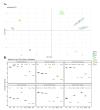Microalgae as Sustainable Bio-Factories of Healthy Lipids: Evaluating Fatty Acid Content and Antioxidant Activity
- PMID: 34201621
- PMCID: PMC8307217
- DOI: 10.3390/md19070357
Microalgae as Sustainable Bio-Factories of Healthy Lipids: Evaluating Fatty Acid Content and Antioxidant Activity
Abstract
The demand for sustainable and environmentally friendly food sources and food ingredients is increasing, and microalgae are promoted as a sustainable source of essential and bioactive lipids, with high levels of omega-3 fatty acids (ω-3 FA), comparable to those of fish. However, most FA screening studies on algae are scattered or use different methodologies, preventing a true comparison of its content between microalgae. In this work, we used gas-chromatography mass-spectrometry (GC-MS) to characterize the FA profile of seven different commercial microalgae with biotechnological applications (Chlorella vulgaris, Chlorococcum amblystomatis, Scenedesmus obliquus, Tetraselmis chui, Phaeodactylum tricornutum, Spirulina sp., and Nannochloropsis oceanica). Screening for antioxidant activity was also performed to understand the relationship between FA profile and bioactivity. Microalgae exhibited specific FA profiles with a different composition, namely in the ω-3 FA profile, but with species of the same phylum showing similar tendencies. The different lipid extracts showed similar antioxidant activities, but with a low activity of the extracts of Nannochloropsis oceanica. Overall, this study provides a direct comparison of FA profiles between microalgae species, supporting the role of these species as alternative, sustainable, and healthy sources of essential lipids.
Keywords: GC-MS; fatty acids; lipidomics; lipids; mass spectrometry; microalgae.
Conflict of interest statement
The authors declare no conflict of interest.
Figures



Similar articles
-
Freshwater microalgae biomasses are a source of bioaccessible bioactive compounds and have antioxidant, antihypertensive, and antidiabetic activity.Food Res Int. 2025 May;208:116259. doi: 10.1016/j.foodres.2025.116259. Epub 2025 Mar 15. Food Res Int. 2025. PMID: 40263856
-
Tracing the Impact of Domestic Storage Conditions on Antioxidant Activity and Lipid Profiles in the Edible Microalgae Chlorella vulgaris and Tetraselmis chui.Mar Drugs. 2024 May 30;22(6):254. doi: 10.3390/md22060254. Mar Drugs. 2024. PMID: 38921565 Free PMC article.
-
Polar lipidomic profile shows Chlorococcum amblystomatis as a promising source of value-added lipids.Sci Rep. 2021 Feb 23;11(1):4355. doi: 10.1038/s41598-021-83455-y. Sci Rep. 2021. PMID: 33623097 Free PMC article.
-
Edible Microalgae and Their Bioactive Compounds in the Prevention and Treatment of Metabolic Alterations.Nutrients. 2021 Feb 9;13(2):563. doi: 10.3390/nu13020563. Nutrients. 2021. PMID: 33572056 Free PMC article. Review.
-
In-situ lipid and fatty acid extraction methods to recover viable products from Nannochloropsis sp.Sci Total Environ. 2020 Dec 15;748:142464. doi: 10.1016/j.scitotenv.2020.142464. Epub 2020 Sep 23. Sci Total Environ. 2020. PMID: 33113682 Review.
Cited by
-
Bioactive Lipids in Dunaliella salina: Implications for Functional Foods and Health.Foods. 2024 Oct 19;13(20):3321. doi: 10.3390/foods13203321. Foods. 2024. PMID: 39456383 Free PMC article.
-
Ethanol Extraction of Polar Lipids from Nannochloropsis oceanica for Food, Feed, and Biotechnology Applications Evaluated Using Lipidomic Approaches.Mar Drugs. 2021 Oct 21;19(11):593. doi: 10.3390/md19110593. Mar Drugs. 2021. PMID: 34822464 Free PMC article.
-
Use of Chlorella vulgaris Lipidic Extracts in the Development of Healthier Pastry Products with Reduced Fat Contents.Foods. 2024 Dec 4;13(23):3913. doi: 10.3390/foods13233913. Foods. 2024. PMID: 39682985 Free PMC article.
-
Recent Advancements and Future Perspectives of Microalgae-Derived Pharmaceuticals.Mar Drugs. 2021 Dec 12;19(12):703. doi: 10.3390/md19120703. Mar Drugs. 2021. PMID: 34940702 Free PMC article. Review.
-
Differences and Similarities in Lipid Composition, Nutritional Value, and Bioactive Potential of Four Edible Chlorella vulgaris Strains.Foods. 2023 Apr 12;12(8):1625. doi: 10.3390/foods12081625. Foods. 2023. PMID: 37107420 Free PMC article.
References
-
- Katiyar R., Arora A. Health promoting functional lipids from microalgae pool: A review. Algal Res. 2020;46:101800. doi: 10.1016/j.algal.2020.101800. - DOI
-
- Maltsev Y., Maltseva K. Fatty acids of microalgae: Diversity and applications. Rev. Environ. Sci. Bio. Technol. 2021;20:515–547. doi: 10.1007/s11157-021-09571-3. - DOI
MeSH terms
Substances
Grants and funding
LinkOut - more resources
Full Text Sources
Medical
Miscellaneous

